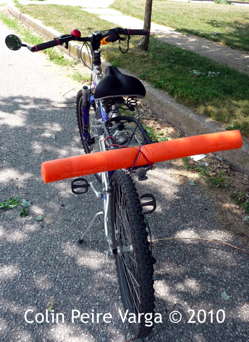|
"Since I've become more observant of how bikes and cars
interact, I've decided that bicyclists have two major safety
threats: cars and themselves." --
Lee Nichols
|
This page shows you real ways you can get hit and real ways to avoid them. This is a far cry from normal bicycle safety guides, which usually tell you little more than to wear your helmet and to follow the law. But consider this for a moment: Wearing a helmet will do absolutely nothing to prevent you from getting hit by a car. Sure, helmets might help you if you get hit, but your #1 goal should be to avoid getting hit in the first place. Plenty of cyclists are killed by cars even though they were wearing helmets. Ironically, if they had ridden without helmets, yet followed the advice on this page, they might still be alive today. Don't fall for the myth that wearing a helmet is the first and last word in biking safety. In truth, an ounce of prevention is worth a pound of cure. It's better to not get hit. That's what real bicycle safety is about.
TIP: The
Uninsured Motorist clause on your auto insurance
may pay if you're hit & runned while
bicycling. Check your policy. The other problem with the "follow the law" message is that people may think that's all they need to do. But following the law is not enough to keep you safe, not by a long shot. Here's an example: The law tells you to ride as far to the right as is practicable. But if you ride too far to the right, someone exiting a parked car could open their door right in front of you, and you'll be less visible to motorists pulling out of driveways and parking lots, and motorists coming from behind may pass you way too closely in the same lane because you didn't make them change lanes. In each of these cases you were following the law, but you made it easier for yourself to get hit. This page doesn't focus on the law, it focuses on how to not get hit by cars. Now let's see how to avoid getting hit.
How to avoid this collision: 1. Get a headlight. If you're riding at night, you absolutely should be using a front headlight. It's required by law, anyway. Even for daytime riding, a bright white light that has a flashing mode can make you more visible to motorists who might otherwise Right Cross you. Look for the new LED headlights which last ten times as long on a set of batteries as old-style lights. And headlamps (mounted on your head or helmet) are the best, because then you can look directly at the driver to make sure they see your light. 2. Wave. If you can't make eye contact with the driver, wave your arm. It's easier for them to see your arm going left and right than it is for them to see a bicycle coming straight towards them. You could also use a loud horn (like the Air Zound) to get drivers' attention. If it looks like the driver is about to pull out without seeing you, yell "Hey!" You may feel awkward waving or yelling, but it's better to be embarrassed than to get hit. Incidentally, many countries require bells on bicycles, but the U.S. doesn't. 3. Slow down. If you can't make eye contact with the driver (especially at night), slow down so much that you're able to completely stop if you have to. Sure, it's inconvenient, but it beats getting hit. Doing this has saved my life on too many occasions to count. 4. Ride further left. You're
probably
used to riding in the "A" line in the picture, very close to the
curb, because you're worried about being hit from behind.
But take a look at the car. When that driver is looking
down the road for traffic, he's not looking in the bike lane or
the area closest to the curb; he's looking in the middle
of the lane, for other cars. The farther left you are
(such as in "B"), the more likely the driver will see you.
There's an added bonus here: if the motorist doesn't see you and
starts pulling out, you may be able to go even farther
left, or may be able to speed up and get out of the way before
impact, or easily roll onto their hood as they slam on their
brakes. In short, it gives you some options. Because
if you stay all the way to the right and they pull out, your
only "option" may be to run right into the driver's side
door. Using this method has saved me on three
occasions in which a motorist ran into me slowly as they hit
their brakes and I wasn't hurt, and in which I definitely
would have slammed into the driver's side door had I not moved
left. You might worry that moving left makes you more vulnerable to cars coming from behind. But the stats say you're far more likely to get hit by a car at an intersection ahead of you that can't see you, than from a car behind you which can see you clearly. So while both positions have risk, you generally reduce your risk by riding a little farther left. Your actual lane position depends on road conditions. On fast roadways with few cross streets (and thus less chances to get hit at intersections), you'll ride farther to the right. On slow roads with many cross streets, you'll ride farther left. See lane position for more about this.
How to avoid this collision: Ride to the left. Ride far enough to the left that you won't run into any door that's opened unexpectedly. You may be wary about riding so far into the lane that cars can't pass you easily, but you're more likely to get doored by a parked car if you ride too close to it than you are to get hit from behind by a car which can see you clearly.
 You're
riding on the sidewalk, you cross the street at a crosswalk,
and a car makes a right turn, right into you. Drivers
aren't expecting bikes in the crosswalk, and it's hard for
them to see you because of the nature of turning from one
street to another, so it's very easy for you to get hit this
way. In fact, this collision is so common we've lost
track of the number of people who've told us they were hit
this way, such as Ray
John
Ray. One
study showed that
sidewalk-riding was twice as dangerous as road riding,
and another
study said it's even more
dangerous than that. You're
riding on the sidewalk, you cross the street at a crosswalk,
and a car makes a right turn, right into you. Drivers
aren't expecting bikes in the crosswalk, and it's hard for
them to see you because of the nature of turning from one
street to another, so it's very easy for you to get hit this
way. In fact, this collision is so common we've lost
track of the number of people who've told us they were hit
this way, such as Ray
John
Ray. One
study showed that
sidewalk-riding was twice as dangerous as road riding,
and another
study said it's even more
dangerous than that.How to avoid this collision: 1. Get a headlight. If you're riding at night, a headlight is absolutely essential. It's required by law, anyway. 2. Slow down. Slow down enough that you're able to stop completely if necessary. 3. Don't ride on the sidewalk in the
first place. Crossing between sidewalks is
a fairly dangerous maneuver. If you do it on the left-hand side
of the street, you risk getting slammed as per the diagram. If
you do it on the right-hand side of the street, you risk getting
slammed by a car behind you that's turning right. Sidewalk
riding also makes you vulnerable to cars pulling out of parking
lots or driveways. And you're threatening to pedestrians
on the sidewalk, who could get hurt if you hit them. These
kinds of accidents are hard to avoid, which is a compelling
reason to not ride on the sidewalk in the first place. In
addition, riding on the sidewalk is illegal in some places. Some special sidewalks are safe to ride on.
If
the sidewalk is really long (no need to frequently cross
streets), and free of driveways and peds, then there's little
risk to you and others. Just make sure when you do
cross a street or driveway that you slow down considerably
and that you check the traffic in all directions,
especially behind you if you're riding with the flow of traffic.
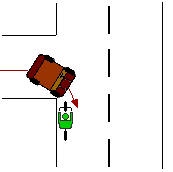 You're
riding the wrong way (against traffic, on the left-hand side
of the street). A car makes a right turn from a side street,
driveway, or parking lot, right into you. They didn't see
you because they were looking for traffic only on their
left, not on their right. They had no reason to expect that
someone would be coming at them from the wrong direction. You're
riding the wrong way (against traffic, on the left-hand side
of the street). A car makes a right turn from a side street,
driveway, or parking lot, right into you. They didn't see
you because they were looking for traffic only on their
left, not on their right. They had no reason to expect that
someone would be coming at them from the wrong direction.
Even worse, you could be hit by a car on the same road coming at you from straight ahead of you. They had less time to see you and take evasive action because they're approaching you faster than normal (because you're going towards them rather than away from them). How to avoid this collision: Don't ride against traffic. Ride with traffic, in the same direction. Riding against traffic may seem like a good idea because you can see the cars that are passing you, but it's not. Here's why:
One study showed that riding the wrong way was three times as dangerous as riding the right way, and for kids, the risk is seven times greater. (source) Nearly one-fourth of crashes involve cyclists riding the wrong way. (source) Some readers have challenged this, saying if 25% of crashes are from going the wrong way, then riding the right way is more dangerous because it accounts for 75% of crashes. That idea is just wrong. First off, only 8% of cyclists ride the wrong way, yet nearly 25% of them get hit -- meaning wrong-way cyclists really are three times more likely to get hit than those who ride the proper way. Second, the problem with wrong-way biking is that it promotes crashes, while right-way biking does not. For example, cyclists running stop signs or red lights is 17% of their crashes. (source) But do we therefore conclude that not running signals causes 83% of crashes?! (Hint: No.)
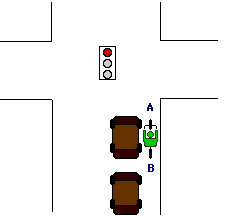 You
stop to the right of a car that's already waiting at a red
light or stop sign. They can't see you. When the light turns
green, you move forward, and then they turn right, right
into you. Even small cars can do you in this way, but
this scenario is especially dangerous when it's a bus or a
semi that you're stopping next to. An Austin cyclist was
killed in 1994 when he stopped to the right of a semi, and
then it turned right. He was crushed under its wheels. You
stop to the right of a car that's already waiting at a red
light or stop sign. They can't see you. When the light turns
green, you move forward, and then they turn right, right
into you. Even small cars can do you in this way, but
this scenario is especially dangerous when it's a bus or a
semi that you're stopping next to. An Austin cyclist was
killed in 1994 when he stopped to the right of a semi, and
then it turned right. He was crushed under its wheels.
How to avoid this collision: Don't stop in the blind spot. Simply stop behind a car, instead of to the right of it, as per the diagram below. This makes you very visible to traffic on all sides. It's impossible for the car behind you to avoid seeing you when you're right in front of it.
If you chose spot A, then ride quickly to cross the street as soon as the light turns green. Don't look at the motorist to see if they want to go ahead and turn. If you're in spot A and they want to turn, then you're in their way. Why did you take spot A if you weren't eager to cross the street when you could? When the light turns green, just go, and go quickly. (But make sure cars aren't running the red light on the cross street, of course.) If you chose spot B, then when the light turns green, DON'T pass the car in front of you -- stay behind it, because it might turn right at any second. If it doesn't make a right turn right away, it may turn right into a driveway or parking lot unexpectedly at any point. Don't count on drivers to signal! They don't. Assume that a car can turn right at any time. (NEVER pass a car on the right!) But try to stay ahead of the car behind you until you're through the intersection, because otherwise they might try to cut you off as they turn right. While we're not advocating running red lights, notice it is in fact safer to run the red light if there's no cross traffic, than it is to wait legally at the red light directly to the right of a car, only to have it make a right turn right into you when the light turns green. The moral here is not that you should break the law, but that you can easily get hurt even if you follow the law. By the way, be very careful when passing stopped cars on the right as you approach a red light. You run the risk of getting doored by a passenger exiting the car on the right side, or hit by a car that unexpectedly decides to pull into a parking space on the right side of the street.
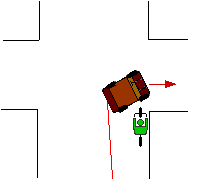 A
car passes you and then tries to make a right turn directly
in front of you, or right into you. They think you're
not going very fast just because you're on a bicycle, so it
never occurs to them that they can't pass you in time. Even if
you have to slam on your brakes to avoid hitting them, they
often won't feel they've done anything wrong. This kind of
collision is very hard to avoid because you typically don't
see it until the last second, and because there's nowhere for
you to go when it happens. A
car passes you and then tries to make a right turn directly
in front of you, or right into you. They think you're
not going very fast just because you're on a bicycle, so it
never occurs to them that they can't pass you in time. Even if
you have to slam on your brakes to avoid hitting them, they
often won't feel they've done anything wrong. This kind of
collision is very hard to avoid because you typically don't
see it until the last second, and because there's nowhere for
you to go when it happens.
How to avoid this collision: 1. Don't ride on the sidewalk. When you come off the sidewalk to cross the street you're invisible to motorists. You're just begging to be hit if you do this. Keith Vick was killed this way in Austin, TX in Dec. 2002. 2. Ride to the left. Taking up the whole lane makes it harder for drivers to pass you to cut you off or turn into you. Don't feel bad about taking the lane: if motorists didn't threaten your life by turning in front of or into you or passing you too closely, then you wouldn't have to. If the lane you're in isn't wide enough for cars to pass you safely, then you should be taking the whole lane anyway. Lane position is discussed in more detail below. 3. Glance in your mirror before approaching an intersection. (If you don't have a handlebar or helmet mirror, get one now.) Be sure to look in your mirror well before you get to the intersection. When you're actually going through an intersection, you'll need to be paying very close attention to what's in front of you.
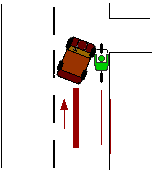 You're
passing a slow-moving car (or even another bike) on the
right, when it unexpectedly makes a right turn right into
you, trying to get to a parking lot,driveway or side street. You're
passing a slow-moving car (or even another bike) on the
right, when it unexpectedly makes a right turn right into
you, trying to get to a parking lot,driveway or side street.
How to avoid this collision: 1. Don't pass on the right. This collision is very easy to avoid. Just don't pass any vehicle on the right. If a car ahead of you is going only 10 mph, then you slow down, too, behind it. It will eventually start moving faster. If it doesn't, pass on the left when it's safe to do so. When passing cyclists on the left, announce "on your left" before you start passing, so they don't suddenly move left into you. (Of course, they're much less likely to suddenly move left without looking, where they could be hit by traffic, then to suddenly move right, into a destination.) If they're riding too far to the left for you to pass safely on the left, then announce "on your right" before passing on the right. If several cars are stopped at a light, then you can try passing on the right cautiously. Remember that someone can fling open the passenger door unexpectedly as they exit the car. Also remember that if you pass on the right and traffic starts moving again unexpectedly, you may suffer #3, the Red Light of Death. Note that when you're tailing a slow-moving vehicle, ride behind it, not in its blind spot immediately to the right of it. Even if you're not passing a car on the right, you could still run into it if it turns right while you're right next to it. Give yourself enough room to brake if it turns. 2. Look behind you before turning right. Here's your opportunity to avoid hitting cyclists who violate tip #1 above and try to pass you on the right. Look behind you before making a right-hand turn to make sure a bike isn't trying to pass you. (Also remember that they could be coming up from behind you on the sidewalk while you're on the street.) Even if it's the other cyclist's fault for trying to pass you on the right when you make a right turn and have them slam into you, it won't hurt any less when they hit you.
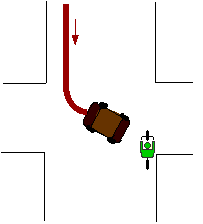 A
car coming towards you makes a left turn right in front of
you, or right into you. This is similar to #1, above.
Austin cyclists hit this way include Dr.
Lee Chilton, John
Howell (former president of the
Austin Cycling Association), and Janne
Osborne. A
car coming towards you makes a left turn right in front of
you, or right into you. This is similar to #1, above.
Austin cyclists hit this way include Dr.
Lee Chilton, John
Howell (former president of the
Austin Cycling Association), and Janne
Osborne.
How to avoid this collision: 1. Don't ride on the sidewalk. When you come off the sidewalk to cross the street, you're invisible to turning motorists. 2. Get a headlight. If you're riding at night, you should absolutely use a front headlight. It's required by law in most countries, anyway. 3. Wear something bright, even during the day. It may seem silly, but bikes are small and easy to see through even during the day. Yellow or orange reflective vests really make a big difference. Reflective leg bands are also easy and inexpensive. 4. Don't pass on the right. Don't overtake slow-moving vehicles on the right. Doing so makes you invisible to left-turning motorists at intersections. Passing on the right means that the vehicle you're passing could also make a right turn right into you, too. 5. Slow down. If you can't
make eye contact with the driver (especially at night), slow
down so much that you're able to completely stop if you have to.
Sure, it's inconvenient, but it beats getting hit.
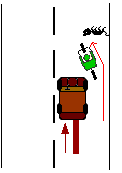 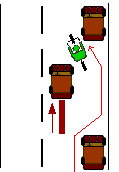 You
innocently
move a little to the left to go around a parked car or some
other obstruction in the road, and you get nailed by a car
coming up from behind. You
innocently
move a little to the left to go around a parked car or some
other obstruction in the road, and you get nailed by a car
coming up from behind.
How to avoid this collision: 1. Never, ever move left without looking behind you first. Some motorists like to pass cyclists within mere inches, so moving even a tiny bit to the left unexpectedly could put you in the path of a car. Practice holding a straight line while looking over your shoulder until you can do it perfectly. Most new cyclists tend to move left when they look behind them, which of course can be disastrous. 2. Don't swerve in and out of the parking lane if it contains any parked cars. You might be tempted to ride in the parking lane where there are no parked cars, dipping back into the traffic lane when you encounter a parked car. This puts you at risk for getting nailed from behind. Instead, ride a steady, straight line in the traffic lane. 3. Use a mirror. If you don't have one, get one from a bike shop or an online shop right now. There are models that fit on your handlebars, helmet, or glasses, as you prefer. You should always physically look back over your shoulder before moving left, but having a mirror still helps you monitor traffic without constantly having to look behind you. 4. Signal. Never move left
without signaling. Just put your left arm straight out. Be sure
to check your mirror or loo behind you before signaling (since a
car passing too closely can take your arm out).
 A
car runs into you from behind. This is what many cyclists
fear the most, but it's actually not very common, comprising
only 3.8% of collisions. (source)
However, it's one of the hardest collisions to avoid, since
you're not usually looking behind you. The risk is
likely greater at night, and in rides outside the city where
traffic is faster and lighting is worse. The three cyclists
killed when hit from behind in Austin in 96-97 were all riding
at night, and at least two of them didn't have lights on their
bikes. (source)
The best way to avoid getting Rear-Ended is to ride on very
wide roads or in bike lanes, or on roads where the traffic
moves slowly, and to use lights when biking at night. A
car runs into you from behind. This is what many cyclists
fear the most, but it's actually not very common, comprising
only 3.8% of collisions. (source)
However, it's one of the hardest collisions to avoid, since
you're not usually looking behind you. The risk is
likely greater at night, and in rides outside the city where
traffic is faster and lighting is worse. The three cyclists
killed when hit from behind in Austin in 96-97 were all riding
at night, and at least two of them didn't have lights on their
bikes. (source)
The best way to avoid getting Rear-Ended is to ride on very
wide roads or in bike lanes, or on roads where the traffic
moves slowly, and to use lights when biking at night.
How to avoid this collision: 1. Get a rear light. If you're riding at night, you absolutely should use a flashing red rear light. Bruce Mackey (formerly of Florida, now head of bike safety in Nevada) says that 60% of bike collisions in Florida are caused by cyclists riding at night without lights. In 1999, 39% of deaths on bicycles nationwide occurred between 6 p.m. and midnight. [USA Today, 10-22-01, attributed to the Insurance Institute for highway safety] Bike shops have red rear blinkies for $15 or less. These kind of lights typically take two AA batteries, which last for months (something like 200 hours). I can't stress this item enough: If you ride at night, get a rear light!
3. Choose wide streets. Ride on streets whose outside lane is so wide that it can easily fit a car and a bike side by side. That way a car may zoom by you and avoid hitting you, even if they didn't see you! 4. Choose slow streets. The slower a car is going, the more time the driver has to see you. I navigate the city by going through neighborhoods. Learn how to do this. 5. Use back streets on weekends. The risk of riding on Friday or Saturday night is much greater than riding on other nights because all the drunks are out driving around. If you do ride on a weekend night, make sure to take neighborhood streets rather than arterials. 6. Get a mirror. Get a mirror and use it. If it looks like a car doesn't see you, hop off your bike and onto the sidewalk. Mirrors cost $5-15. Trust me, once you've ridden a mirror for a while, you'll wonder how you got along without it. My paranoia went down 80% after I got a mirror. If you're not convinced, after you've used your mirror for a month, take it off your bike and ride around and notice how you keep glancing down to where your mirror was, and notice how unsafe you feel without it. 7. Don't hug the curb. This is counter-intuitive, but give yourself a little space between yourself and the curb. That gives you some room to move into in case you see a large vehicle in your mirror approaching without moving over far enough to avoid you. Also, when you hug the curb tightly you're more likely to suffer a right cross from motorists who can't see you. |
New additions: Sample Fan Mail Fantastic web site! I've been a bicycle commuter for about 13 years now and I think you've nailed it very nicely. I was recently clipped while passing a slow-moving truck and trailer on the right in a dedicated right-turn lane. I've ridden the same route for over 6 years but failed to follow your advice about busy roads [and about not passing on the right!]. During that time traffic got worse and worse while I became more and more complacent. While passing that truck and trailer, a dually pickup passing me up on my left, caught my handlebar with its rear flared out fender, and took me down in a busy intersection. We were both going about the same speed so it was the pavement that did the hurting, but we were doing about 30mph. My helmet was crushed from the impact and I broke 3 ribs along with the usual road rash and a perforation in one arm from some road debris. Obviously I was lucky, the helmet worked so well, I didn't even gat a headache. But it points out the need to reassess your route periodically and be willing to change your route accordingly. --Adam Fischer, Riverside, CA I just read your BicycleSafe article. I've been riding in cities (mainly Cleveland and Winnipeg) for 45 years or so. I've experienced all of the types of incident you describe. Fortunately I only got knocked off the bike once many years ago - a left cross in a thunderstorm going too fast with a gale behind me - dummy! Bike brakes don't work as well in the rain and drivers don't have the visibility. I'd encourage cyclists to keep the speed below about 15 MPH in city traffic. At that speed, I find I have the reaction time and stopping distance to handle most emergencies. Thanks for posting the article. I bet you save a few lives! --Alan McIlwain, August 2006 I just wanted to let you know how much I appreciated your Bicycle Safety site. I biked to work for the first time here in S.F. today, and although my time on a motorcycle made me rightfully paranoid, I see I made a lot of small mistakes that could add up to a big problem some unlucky day. So, I totally appreciate that you took the time to put bicyclesafe.com together. --Josh Krist, author of San Francisco: The Unknown City, June 2006 Thanks for your site. I just experienced the Right Hook Part 1 yesterday. Your site makes me feel better knowing that these things happen to bicyclists everywhere. Anywho, thanks! -- Natalie Ma, May 2006 Your website is great! I've been biking to work every day for a year and a half, and I really wish I had seen your site first. I'm referring people (especially those who have never bike commuted) to your site now as I'm coordinating a Bike to Work Day event at my office. Your approach to safe, defensive bike riding and the illustrations you use are greatly appreciated! Many thanks! -- Jessi Hafer, Fresno, CA, May 2006
Reflective Stickers Stickers help you be seen by cars, even during the day. Here are some sites selling reflective stickers and tape:
Lighting These are neat:
Reflective Clothing
Other Bicycle Safety Resources Urban Cycling's directory of bike safety advice from various sources
Bicycle Safety Statistics Our sister site has everything we know about bicycle safety statistics. That's it, that's all we have, no need to ask if we have anything more.
Why you don't see "wear a helmet" advice plastered all over this site Everybody asks about this one, so here's the answer.
Note to "Effective Cycling" fans If you're about to send me an email telling me how stupid the advice on this site is, please save yourself the trouble. Trust me, I've heard all the arguments before (ad nauseum) and I simply disagree. I never write to EC websites to complain that I don't like their advice, so there's no need for you to complain about mine. (Here's more about the the difference of opinion for those wondering what the fuss is about.) Reprint & Link Permission I'm happy to share this information with others at no cost. Permission to reprint is given freely, subject to the following provisions:
The contents of BicycleSafe.com are Copyright ©1998-2008 by Michael Bluejay and may not be sold for profit. Disclaimer I have developed this page to provide what I believe is very good advice to help you avoid getting hit by cars. But of course, bicycling will never be 100% safe, and I can't guarantee you won't get hit by a car, even if you follow all the advice on this page. (Naturally, I believe if you follow this advice you will be much less likely to suffer a collision than if you ignore it.) Ultimately, you are responsible for your own safety.
A plug for another site of mine. I was born into a cult called Aesthetic Realism. Now I run a website where ex-members share their stories about it. Check it out at NewYorkCult.com. |
|
|
||
Avoid busy streets.One of the biggest mistakes that people make when they start biking is to take the exact same routes they used when they were driving. It's usually better to take different streets with fewer and slower cars. Sure, cyclists have a right to the road, but that's a small consolation when you're dead. Consider how far you can take this strategy: If you learn your routes well, you'll find that in many cities you can travel through neighborhoods to get to most places, only crossing the busiest streets rather than traveling on them. Light up.Too obvious? Well, if it's so obvious, then why do most night-time cyclists ride without lights? Bike shops have rear red blinkies for $15 or less. Headlights are just as important as rear lights. And modern headlights use LED's so the batteries last ten times longer than old-school headlights.
Take the whole lane when appropriate.It's often safer to take the whole lane, or at least ride a little bit to the left, rather than hug the right curb. Here's why:
You might worry about slowing down the traffic behind you if you take the lane. But if you're on the kind of street where you've got cars blocked up behind you or constantly changing lanes to get around you, you're probably on the wrong street and should find a quieter neighborhood street. Taking the lane works especially well in most traffic circles. The traffic generally moves slower so it's easy to keep up, riding in the lane makes you more visible to motorists, and taking the lane prevents motorists from right hooking you as they exit the circle. It's perfectly legal for you to take the lane when appropriate. Texas State Law (and the laws of most other states) says you have to ride as far to the right as is "practicable". Here are some things that make it impracticable to ride to the extreme right:
There are risks to both riding to the extreme right as well as taking the lane. Whether you ride to the right or take the lane depends on the conditions of the roadway you're on. On wide roadways with few intersections/driveways, right further right. On narrow roads with lots of intersections, ride farther to the left. It's not always better to take the lane or to hug the curb; it depends on the roadway you're on. |
Signal your turns.You're less likely to get hit when your movement doesn't take motorists by surprise. Let them know you're about to turn or move left or right by signalling with your arm. Point your left arm out to move left, and point your right arm out to move right. (You might have learned an old way of signaling a right turn with your left arm, but drivers have no idea what that means, so it's useless. Signal a right turn with your right arm.) Before signaling left, be sure to check your mirror or look behind you before signaling (since a car passing too closely can take your arm out). Re-think music players and mobile phones.It's more important to hear what's around you when you're biking than when you're driving. Whether you want to ride with headphones is your choice, but doing so does increase your risk. Similarly, texting or talking with a mobile phone raises the risk level. When you're mixing with car traffic, the fewer distractions the better. Also, you'll want both hands free in case you have to brake suddenly. Ride as if you were invisible.It's often helpful to ride in such a way that motorists won't hit you even if they don't see you. You're not trying to be invisible, you're trying to make it irrelevant whether cars see you or not. If you ride in such a way that a car has to see you to take action to avoid hitting you (e.g., by their slowing down or changing lanes), then that means they will definitely hit you if they don't see you. But if you stay out of their way, then you won't get hit even if they didn't notice you were there. On very fast roads cars have less time to see you because they're approaching so fast. Of course, you should avoid fast roads in the first place if at all possible, unless there's plenty of room for a car and a bike side by side. And if there IS such room, then on fast roadways, you can practice invisibility by riding to the extreme right. If you're far enough right that you're not in the part of the lane the cars are in, then they'll zoom by and won't hit you, even if they never saw you. Here's another example: It's a good idea to signal a left turn, but it's a better idea to make your left turn at a time or place where there aren't cars behind you that could hit you while you're stopped and waiting to make that turn. You can hang out in the middle of the street, stopped, with your left arm out, waiting to make your turn, but you're counting on cars behind you to see you and stop. If they don't see you, you're in trouble. Naturally we don't advocate running red lights, but if you're the kind of person who does, then apply the invisibility principle when deciding on whether to run a particular light: Could any cross traffic possibly hit me if I were invisible? If yes, then absolutely don't do it. Never make a car have to slow down to avoid hitting you (red light or not). Remember, the more you rely on cars to see you to avoid hitting you, the more chances they'll have to actually do so. Remember, you're not trying to BE invisible, you're just riding with the assumption that cars can't see you. Of course, you certainly want them to see you, and you should help them with that. That's why you'll wave to motorists whom you think might be about to pull out in front of you, and why you'll be lit up like a Christmas tree at night (front and rear lights). Remember that in many cases you'll need to take the lane, in which case you're counting on motorists to see you. |
|
|
About 1 in 41 is a bicyclist. THANKS FOR READING, AND RIDE SAFELY! :) |
|
If you like this site, you might like some of my other sites:
|
|
|

| |||||
|
Last Update: May 2013

 This
is the most common way to get hit (or almost get hit).(
This
is the most common way to get hit (or almost get hit).(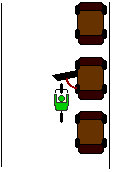 A
driver opens his door right in front of you. You run
right into it if you can't stop in time. This kind
of crash is more common than you might think: It's the
second-most common car-bike crash in Toronto,(
A
driver opens his door right in front of you. You run
right into it if you can't stop in time. This kind
of crash is more common than you might think: It's the
second-most common car-bike crash in Toronto,(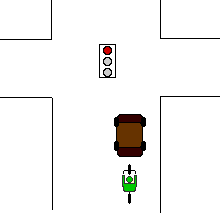 Another
option is to stop at either point A in the diagram above (where
the first driver can see you), or at point B, behind the first
car so it can't turn into you, and far enough ahead of the
second car so that the second driver can see you clearly. It
does no good to avoid stopping to the right of the first car if
you're going to make the mistake of stopping to the right of the
second car. EITHER car can do you in.
Another
option is to stop at either point A in the diagram above (where
the first driver can see you), or at point B, behind the first
car so it can't turn into you, and far enough ahead of the
second car so that the second driver can see you clearly. It
does no good to avoid stopping to the right of the first car if
you're going to make the mistake of stopping to the right of the
second car. EITHER car can do you in.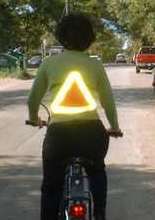 2.
Wear a reflective vest or a safety triangle. High
quality reflective gear makes you a lot more visible even in the
day time, not just at night. I had a friend ride away from me
while wearing one during the day, and when she was about a
quarter mile away, I couldn't see her or her bike at all, but
the vest was clearly visible. At night the difference is even
greater. Bike shops have vests and triangles for $10 to $15.
Also, when you hear a motorist approaching, straightening up
into a vertical position will make your reflective gear more
noticeable.
2.
Wear a reflective vest or a safety triangle. High
quality reflective gear makes you a lot more visible even in the
day time, not just at night. I had a friend ride away from me
while wearing one during the day, and when she was about a
quarter mile away, I couldn't see her or her bike at all, but
the vest was clearly visible. At night the difference is even
greater. Bike shops have vests and triangles for $10 to $15.
Also, when you hear a motorist approaching, straightening up
into a vertical position will make your reflective gear more
noticeable.
